
Drasteria is a genus of moths in the family Erebidae.
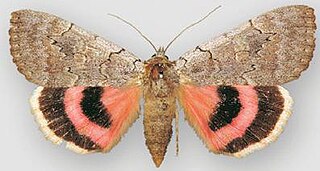
Catocala concumbens, the sleepy underwing or pink underwing, is a moth of the family Erebidae. The species was first described by Francis Walker in 1858. It is found in eastern North America, west across the southern half of the Prairie Provinces to eastern Alberta.

Catocala junctura, the joined underwing or Stretch's underwing, is a moth in the family Erebidae. The species was first described by Francis Walker in 1858. It is found throughout temperate North America, ranging from New York and Pennsylvania west to Montana, Colorado, Oklahoma, Arizona, and into Texas, and north to southern Illinois, extreme southern Alberta and Saskatchewan; it has also been recorded west of the Rocky Mountains from California and south-eastern British Columbia. It is typically found near water, where the food plants of its caterpillar larvae grow plentifully.
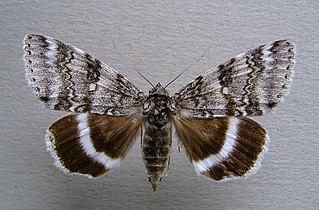
Catocala relicta, the white underwing or relict, is a moth of the family Erebidae. The species was first described by Francis Walker in 1858. It lives in southern Canada, from Newfoundland to Vancouver Island, south to Missouri, and Arizona.
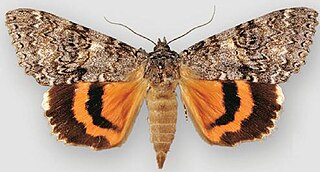
Catocala unijuga, the once-married underwing, is a moth of the family Erebidae. The species was first described by Francis Walker in 1858. It is found in North America from Newfoundland west to south central British Columbia, south to Kentucky and Missouri in the east, Colorado and Utah in the west.

Drasteria adumbrata, the shadowy arches, is a moth of the family Erebidae. The species was first described by Hans Hermann Behr in 1870. It is found from coast to coast in southern Canada, south in the west to California and Colorado, south in the east to New England and Michigan. Subspecies D. a. alleni is found from eastern Alberta to New York and Nova Scotia. Subspecies D. a. saxea occurs from southern British Columbia and south-west Alberta south to California and Colorado.
Drasteria hudsonica, the northern arches, is a moth of the family Erebidae. The species was first described by Augustus Radcliffe Grote and Coleman Townsend Robinson in 1865. It is found from Alaska and Yukon to California, east to New Mexico and Manitoba.

Drasteria pallescens, the cowhead arches, is a moth of the family Erebidae. The species was first described by Augustus Radcliffe Grote and Coleman Townsend Robinson in 1866. It is found in North America from Alberta and Saskatchewan south to Texas and Baja California.
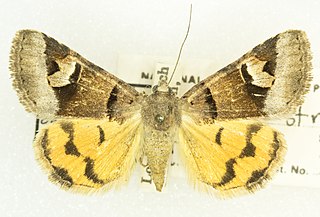
Drasteria perplexa, the perplexing or perplexed arches, is a moth of the family Erebidae. The species was first described by Henry Edwards in 1884. It is found in North America from Alberta and Saskatchewan south to Colorado and Arizona.

Drasteria divergens is a moth of the family Erebidae. It is found from California to Colorado, north to British Columbia.

Drasteria grandirena, the figure-seven moth or great kidney, is a moth of the family Erebidae first described by Adrian Hardy Haworth in 1809. It is found in North America from Ontario, Quebec and Nova Scotia, south to at least Georgia west to at least Arkansas

Drasteria howlandii is a moth of the family Erebidae. It is found from British Columbia and Saskatchewan south through the western parts of the United States from Washington south to Arizona and Texas.
Drasteria ingeniculata is a moth of the family Erebidae. It is found in south-central United States.

Drasteria fumosa, the smoky arches, is a species of moth in the family Erebidae first described by Strecker in 1898. It is found from the US state of California east to Utah and Texas.
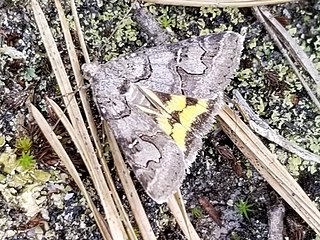
Drasteria graphica, the graphic moth, is a moth of the family Erebidae. The species was first described by Jacob Hübner in 1818. It is found in the United States in coastal dunes from Maine to Florida, west to Mississippi. It is also found along the shores of the Great Lakes in Michigan and Wisconsin. Subspecies D. g. atlantica is listed as threatened in Connecticut.
Drasteria inepta, the inept drasteria, is a moth of the family Erebidae. It is found from Arizona to Texas, north to Colorado and Utah.
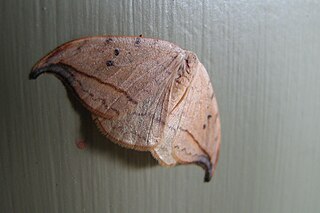
Drepana arcuata, the arched hooktip or masked birch caterpillar, is a moth of the family Drepanidae. The species was first described by Francis Walker in 1855. It is found from Newfoundland to Vancouver Island, south to at least North Carolina, South Carolina and California.
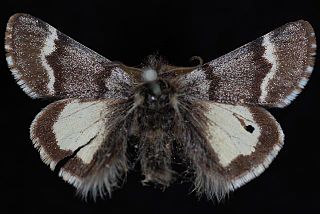
Leucobrephos brephoides, the scarce infant moth, is a moth of the family Geometridae. The species was first described by Francis Walker in 1857. It is found in North America from Yukon to Labrador and south to New York and southern Alberta and British Columbia. The habitat consists of open mixed wood forests of the boreal and mountain region.
Drasteria eubapta is a moth of the family Erebidae. It is found in North America, where it has been recorded from Arizona and California.
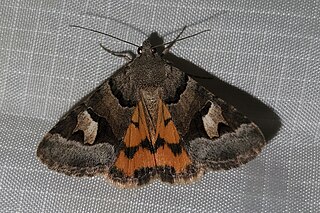
Drasteria stretchii is a species of moth in the family Erebidae. It is found in North America, where it has been recorded from northern Nevada., California, Oregon, Wyoming and Washington. The habitat consists of dry, rocky canyons at low to middle elevations.















